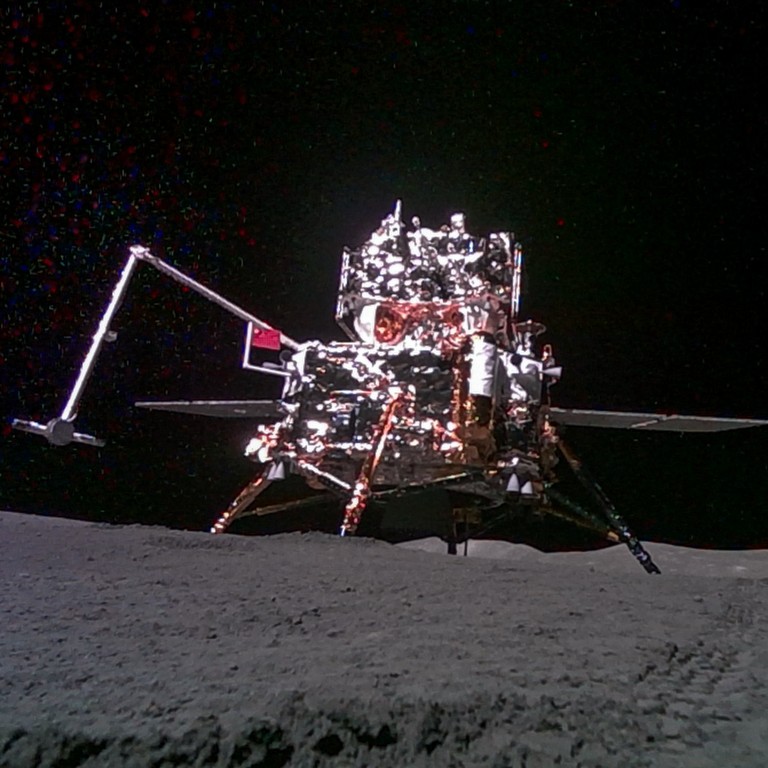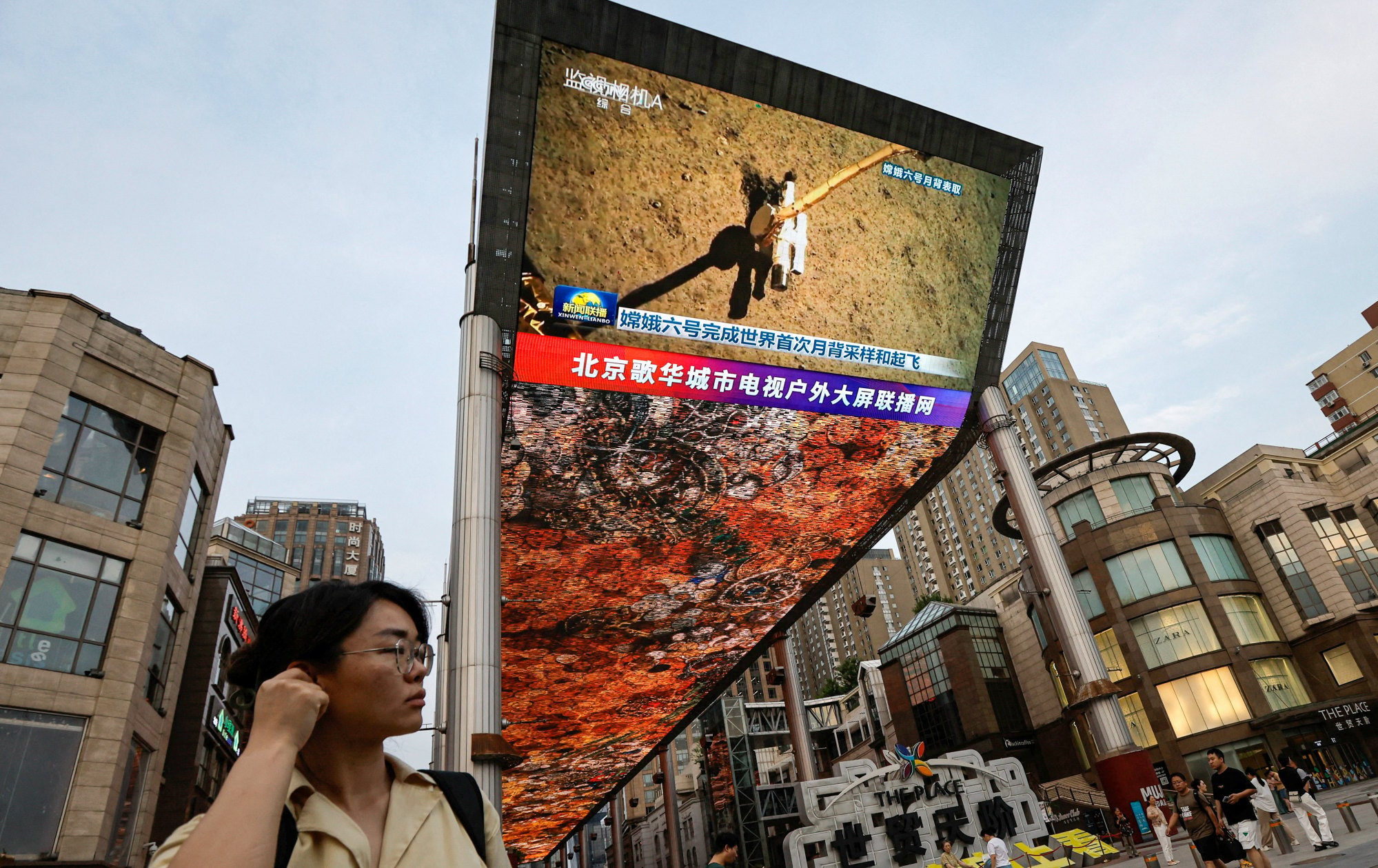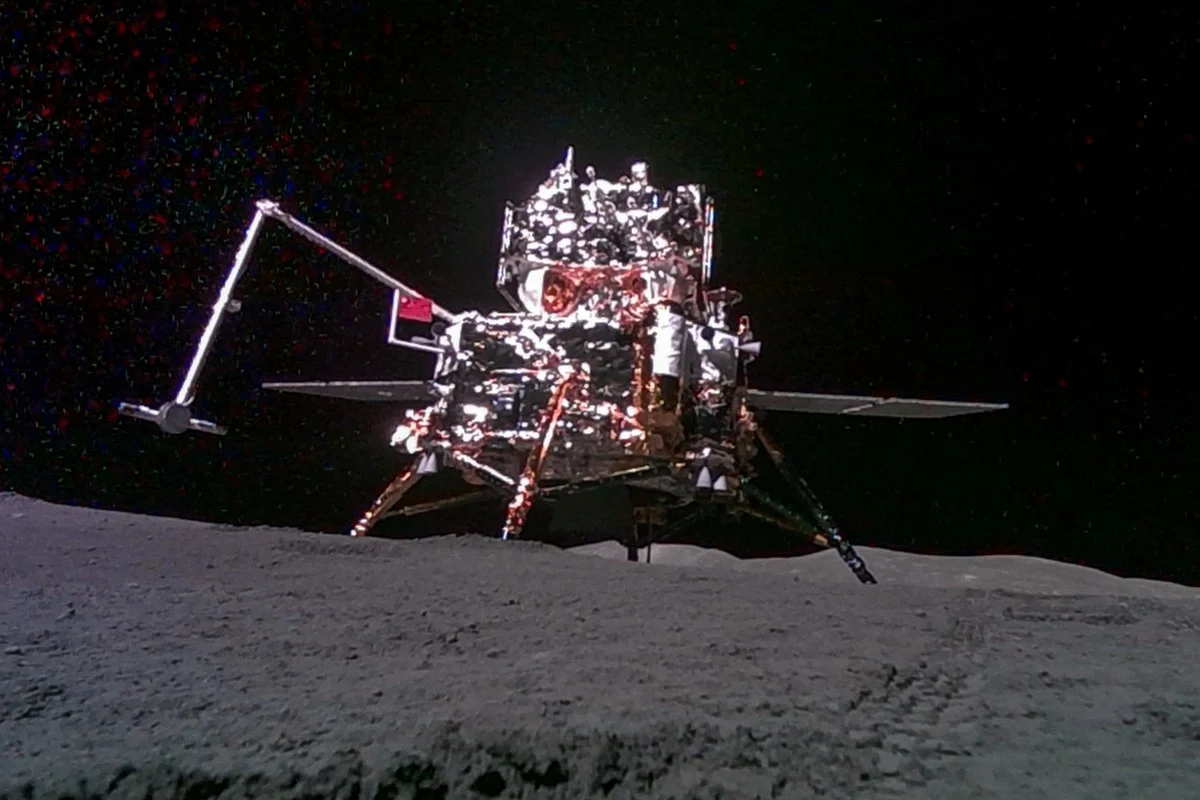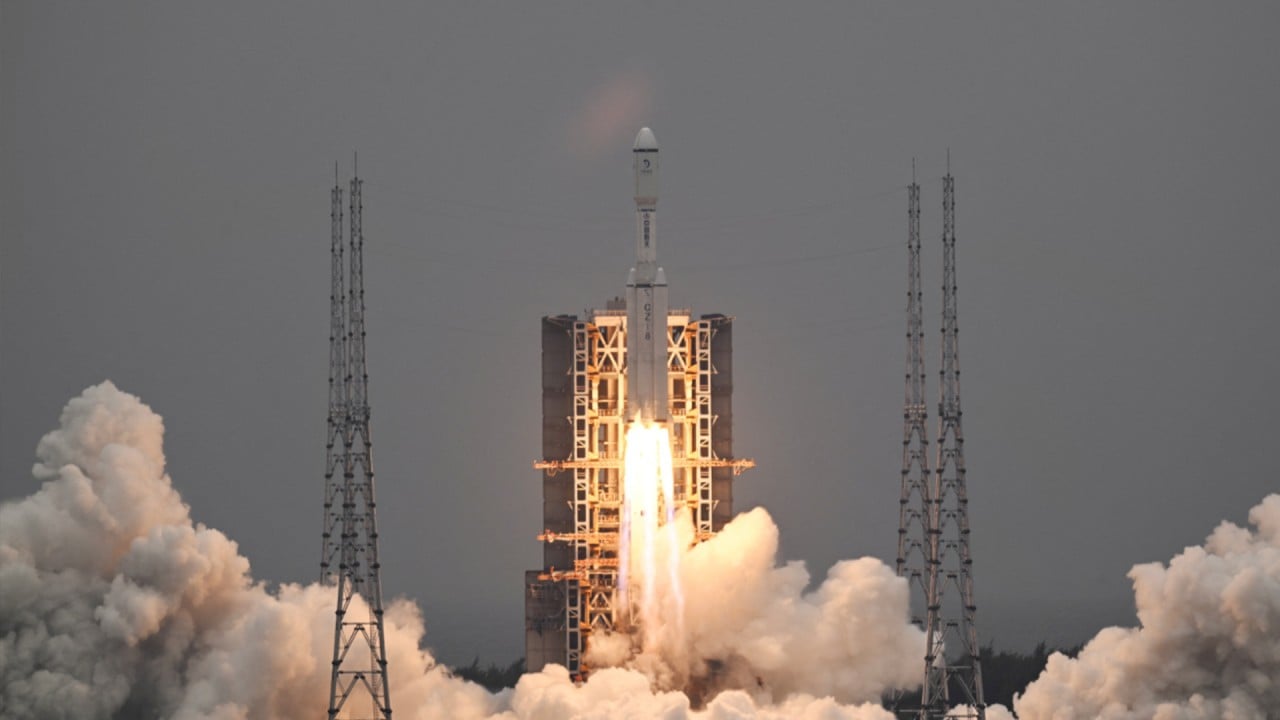
China’s state-owned space company beats private sector to reusable rocket test
- Rocket’s ‘milestone’ hop testing sends it more than 10km into the sky before a controlled descent and precision landing in the Gobi Desert
The vertical take-off-vertical landing (VTVL) test “comprehensively verified” several key technologies, including the rocket’s structural integrity, buffer mechanisms and high-precision navigation during landing, it said.
Powered by three engines burning methane and liquid oxygen, the 3.8-metre (12.5ft) diameter test rocket lifted off from the Jiuquan Satellite Launch Centre at around 1pm Beijing time, according to state-owned newspaper China Space News.
The rocket reached an altitude of 12km (7.5 miles) before the central engine adjusted its thrust to allow a controlled descent. At 50 metres (about 164ft) above the ground, the rocket’s four landing legs were deployed as it slowed to a precise, soft touchdown on the designated recovery pad.
In a statement released after Sunday’s test, SAST said its advancements “paved the way for the maiden flight of our 4-metre (13ft) diameter reusable carrier rocket in 2025”, adding that its next goal is a VTVL test at a level of 70km (43.5 miles).
Seven Yunlong engines – manufactured by leading start-up Jiuzhou Yunjian from Anhui province, eastern China, that is known for its methane-liquid rocket engines – will power the full-sized variant, it said.
Methane, the primary component of natural gas, is more efficient as a rocket fuel, easier to produce and more environmentally friendly than traditional fuels such as refined kerosene.
Other private Chinese companies working on reusable rockets include Space Pioneer, iSpace, Galactic Energy, Deep Blue Aerospace, CAS Space and Orienspace.
In January, LandSpace carried out the first VTVL test for its Zhuque-3 reusable rocket. It reached an altitude of about 350 metres during the 60-second test.
The state-owned China Academy of Launch Vehicle Technology is also working on a reusable version of the Long March 10 rocket, which is designed to be recovered using ropes instead of landing legs, with a maiden flight slated for 2026.

- Rocket’s ‘milestone’ hop testing sends it more than 10km into the sky before a controlled descent and precision landing in the Gobi Desert

Ling Xinin Ohio
Published: 11:28am, 24 Jun 2024
Why you can trust SCMPListen to this article
A state-owned developer has beaten its privately owned rivals to complete China’s most advanced reusable rocket test – a six-minute display of precision and power that lit up the northwestern Gobi Desert on Sunday.
The Shanghai Academy of Spaceflight Technology (SAST) said the 10km (6-mile) “hop test” – in which a rocket shoots up, moves sideways and lands – was a “milestone” in the development of reusable rockets in China.
https://youtube.com/watch?v=exG_M8jgTt0%3Fautoplay%3D1%26origin%3Dhttps%253A%252F%252Fwww.scmp.com%26playsinline%3D1%26rel%3D0%26embed_config%3D%257B%2522adsConfig%2522%253A%257B%2522adTagParameters%2522%253A%257B%2522iu%2522%253A%25228134%252Fscmp%252Fweb%252Fchina_science%252Farticle%252Finstream1%2522%257D%252C%2522disableAds%2522%253Atrue%252C%2522nonPersonalizedAd%2522%253Atrue%257D%252C%2522disabledRelatedVideos%2522%253Atrue%252C%2522enableIma%2522%253Atrue%252C%2522relatedChannels%2522%253A%255B%2522UC4SUWizzKc1tptprBkWjX2Q%2522%255D%257D%26enablejsapi%3D1%26widgetid%3D1
China is boldly going where no one has gone before
The vertical take-off-vertical landing (VTVL) test “comprehensively verified” several key technologies, including the rocket’s structural integrity, buffer mechanisms and high-precision navigation during landing, it said.
Powered by three engines burning methane and liquid oxygen, the 3.8-metre (12.5ft) diameter test rocket lifted off from the Jiuquan Satellite Launch Centre at around 1pm Beijing time, according to state-owned newspaper China Space News.
The rocket reached an altitude of 12km (7.5 miles) before the central engine adjusted its thrust to allow a controlled descent. At 50 metres (about 164ft) above the ground, the rocket’s four landing legs were deployed as it slowed to a precise, soft touchdown on the designated recovery pad.
SAST is part of the China Aerospace Science and Technology Corporation, a main contractor for the country’s space programme, and the achievement puts it in front of a number of private companies hoping to carry out the same test on their rockets this year.
Rivals include the Beijing-based start-up LandSpace, whose Zhuque-2 became the world’s first methane-fuelled rocket to reach orbit last year. Hop testing of its stainless steel 3.35-metre (11ft) diameter Zhuque-3 rocket has been postponed due to engine malfunction.
Daily, Monday to Friday
China at a Glance Newsletter
Your daily must-read of essential stories from China, including politics, economy and current affairs.
By submitting, you consent to receiving marketing emails from SCMP. If you don’t want these, tick here
By registering, you agree to ourT&CandPrivacy Policy
In a statement released after Sunday’s test, SAST said its advancements “paved the way for the maiden flight of our 4-metre (13ft) diameter reusable carrier rocket in 2025”, adding that its next goal is a VTVL test at a level of 70km (43.5 miles).
Seven Yunlong engines – manufactured by leading start-up Jiuzhou Yunjian from Anhui province, eastern China, that is known for its methane-liquid rocket engines – will power the full-sized variant, it said.
Methane, the primary component of natural gas, is more efficient as a rocket fuel, easier to produce and more environmentally friendly than traditional fuels such as refined kerosene.
Other private Chinese companies working on reusable rockets include Space Pioneer, iSpace, Galactic Energy, Deep Blue Aerospace, CAS Space and Orienspace.
In January, LandSpace carried out the first VTVL test for its Zhuque-3 reusable rocket. It reached an altitude of about 350 metres during the 60-second test.
The state-owned China Academy of Launch Vehicle Technology is also working on a reusable version of the Long March 10 rocket, which is designed to be recovered using ropes instead of landing legs, with a maiden flight slated for 2026.

China calls the US a ‘competitor’ in moon race for first time, from a position of strength
- China has outlined its lunar ambitions in a new plan, and for the first time has acknowledged it is in a race for the moon with the US
China said it would never compete with the US on the moon. Now it has changed its mind.
Human exploration of the moon has always been competitive. It began with the tug of war between America and the Soviet Union during the Cold War.
“In the historical context of that period, the race to demonstrate superior political strength made lunar exploration unsustainable,” the plan said.
The new plan, “Strategic Concept of Resource Utilisation Development Route of the International Lunar Research Station”, was written under the leadership of Pei Zhaoyu, deputy director of CNSA’s Lunar Exploration and Space Engineering Centre, and published in the Chinese Journal of Astronautics in April.
“And countries such as the United States do not have a distinct edge in this.”
Washington has long cast China as a rival in this new rush for the moon, seeing the race mainly as a land grab.
But China sees the game differently, according to Pei.
Beijing aims to replicate its earthly success by carrying out large-scale infrastructure construction on the moon. It will help establish technological, manufacturing and economic advantages to encourage more countries to stop following the United States and join China-led efforts to exploit lunar resources, according to the plan.
“The utilisation of lunar resources is a scientific challenge, a technological drive and an economic reward. Efficiency and benefit will be the core evaluation benchmarks, guiding the construction, operation and sustainable development,” Pei’s team wrote.
These hydrogen and oxygen molecules, trapped in lunar soil particles, indicated the potential presence of up to 270 billion tonnes of water resources on the moon, which could be used to produce rocket fuel, water and oxygen for astronauts, Chinese space authorities said on social media.
According to the latest plan, China will launch two large spacecraft in the next few years to conduct detailed explorations of these resources and validate key technologies for resource utilisation. By 2030, collaborative work between humans and intelligent machines is expected to be achieved on the lunar surface.
A “lunar-based resource exploration system covering a wide area of thousands of kilometres and a depth of hundreds of metres” will also be completed in this period.

By 2045, China’s lunar base will have large facilities such as power plants, factories, scientific research institutions, rocket launch sites, tourist centres and a small underground city.
Chinese resource exploration robots will roam the entire lunar surface. It is estimated that more than half of the investment in the construction and operation of these facilities will come from countries other than China, and economic activities will reach a break-even point. Humans will use this base as a starting point to explore Mars.
“China will become a leader in human deep space exploration activities,” the plan said.
China’s first lunar probe, Chang’e-1, was launched in 2007. Because of a lack of experience and confidence, this small, two-tonne satellite circled around the Earth for more than two weeks before heading to the moon.
Immediately after the launch, then-commander-in-chief of the lunar exploration project, Luan Enjie, told Xinhua News Agency: “China will not engage in any form of lunar competition with any country.”
Although the United States started lunar exploration earlier, due to mission delays and funding limitations, “it has lost its absolute leading position”, Pei’s team wrote.
To counter China’s advances, the US government has entrusted private enterprises with critical lunar missions, believing they can construct a lunar base more efficiently than Nasa. To motivate these private players, the US Congress enacted a law affirming the principle: “First to explore, first to own.”
The US Skylab space laboratory operated for less than a year before it crashed, and the core technology of the International Space Station is provided by Russia.







